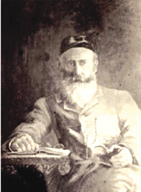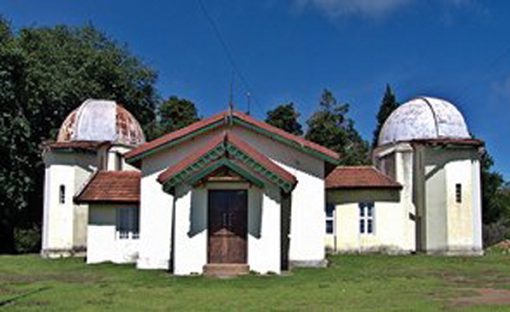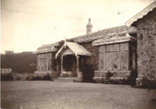(Continued from last fortnight)
It has been about 115 years since the establishment of Kodaikanal Observatory as an extension of the original Madras Observatory, which has evolved into the present Indian Institute of Astrophysics at Bangalore. It is also the first mountain observatory in India. Charles Michie Smith was the man who selected the site, established the observatory and directed it for the first 12 years. He was also the man who recruited John Evershed, discoverer of the famous Evershed effect, and established Kodaikanal Observatory as a major centre for solar physics. Michie Smith, the person, and the establishment of Kodaikanal Observatory are looked at here in the context of the early studies in physical astronomy (observational astrophysics) in India.

Painting of Charlie Michie Smith.
Soon after his appointment, Michie Smith started planning for establishing the observatory, its layout, domes, etc. The first structure to be started at the Kodaikanal site, after acquiring the land (89 acres), was the astronomer’s house, for which foundations were laid at the end of April 1895.
In October 1895, the foundation stone of the new observatory was laid by the Governor. Michie Smith laid the north-south line for the building in July 1897 and handed over the work to the consulting Government architect in December hoping that “if no unforeseen trouble arises, the buildings would be ready to receive instruments in less than six months.” The unforeseen trouble did arise in the form of the Norman Lockyer, a leading British astronomer who was leading an expedition to Madras to study the solar eclipse.

The Kodaikanal Observatory today.
In the Annual Report of 1898-99, Michie Smith writes, “The Government of India requested the Astronomer Royal, and Sir Norman Lockyer to report on the various Indian observatories. The former after visiting Kodaikanal approved generally of the plans for the observatory there and made some suggestions for minor alterations (dome diameter to be changed from 15 feet to 18 feet, etc.) which were at once adapted. Sir Norman Lockyer, on the other hand, without visiting the place (spent some hours in the drawing room of the Astronomer’s house in Madras) objected entirely to the plans and on his return to England represented to the Secretary of State for India that the buildings were ‘too costly and too permanent’ and were badly designed and unsuited for their purpose. He went on to point out that ‘the South Kensington Solar Physics Observatory thus equipped with temporary structures is the most powerful in the world. It does more and better work than the similar institution at Potsdam where the buildings cost £250,000’ and urged that the new buildings at Kodaikanal should be like those at South Kensington shanties, built of wood and canvas. As a consequence, the Secretary of State telegraphed that the work on the observatory was to be stopped till the reports of the Astronomer Royal and Sir Norman Lockyer had been fully considered. To anyone acquainted with the climatic conditions existing in Kodaikanal, the proposal to house valuable instruments in such ‘shanties’ as Sir Norman Lockyer recommends seems as strange as his estimate of the relative values of the work done at South Kensington and Potsdam and the Government Astronomer protested against this proposal. Whether or not this protest was forwarded to the Indian Observatories Committee is not known, but the result was that no reference whatever was made to the buildings thereafter. But a long delay resulted from the antagonism between Michie Smith and Lockyer.”

Astronomer's residence in Kodaikanal Observatory.
Michie Smith complained to the Astronomer Royal, “... Lockyer wished to turn the whole of the Kodaikanal buildings with a series of ‘shanties’ and now you probably know that he has got the Secretary of State to telegraph out to stop all the buildings except the two domes. …Of course I know that Lockyer’s action is taken mainly out of spite against me and I am sure that if the Secretary of State had known of the position he has taken up ever since my appointment he would have asked your advice before taking this action... .” The ‘spite’ which Michie Smith mentions in his letter might partly be due to the fact that Michie Smith lacked proper training in solar physics. Lockyer, on the other hand, was so thoroughly impressed by the work of his “former student”, Naegamvala, “who, so far as I know, is the only person in India particularly familiar with Solar Physics work”, that he was unable to appreciate the effort put in by Michie Smith at Kodaikanal. He had visited Naegamvala in Poona before he arrived in Madras and Naegamvala had shown him “the results he had obtained (of the Total Solar Eclipse) and I found them of a high order of excellence, while the programme of work he undertook showed a large grasp of the various solar problems which await solution at such a time.” (quotes from Lockyer). While he saw an enthusiastic effort being put up at Poona, where he was not expecting any, on the contrary, at Kodaikanal where Lockyer was expecting to see lot of progress, he did not find enough to his liking. As a result, Lockyer was critical about the functioning of Kodaikanal.
While Lockyer was keen on solar physics work to start at Kodaikanal as quickly as possible with as little investment as possible (the idea he was harping on with the Solar Physics Committee from 1893), Michie Smith, on the other hand, was concerned more with establishing a proper observatory. In an earlier letter to Christie, Michie Smith remarked about Lockyer’s intentions: “My interview with Lockyer was trying but we both kept our tempers. His chief object was to try and get me to at once start spectrophotographs of the Sun on the Hale-Deslander plan with an apparatus made up of odds and ends from other instruments set up in a ‘shanty which would not cost £5’. I pointed out that I had neither the necessary apparatus nor at present the time to take it up on which he offered to lend me his son or one of his assistants from South Kensington! I did not jump at the offer. He would like to turn Kodaikanal Observatory into a series of ‘shanties’.”
Anyway, as it turned out, the feud died quietly and things continued (maybe through the intervention of Astronomer Royal) at Kodaikanal with some delay. Officially, the observatory started functioning from April 1, 1899.
During the first few years, the work of the Director was naturally concerned mostly with lay-out, planning the organisation. Smith, the first Director of the Observatory, did much pioneering work in this direction. The construction works were done under his personal supervision. He planted trees for improvement of the solar image, installed the instruments for routine observational work and formulated daily observations.
Systematic solar observations commenced at Kodaikanal from early 1901. Magnetic, meteorological and seismological observations were in progress at Kodaikanal from the very beginning.
Nominations for the position of an assistant to Michie Smith and also a possible successor to him as Director of Kodaikanal, after his retirement, was solicited by John Eliot, the then Director General of Indian Observatories, from the Astronomer Royal and the Indian Observatories Committee in 1902. The position was to be filled, in due course, by John Evershed, by then a well-known practitioner of solar physics and an ‘irresponsible amateur’ (as he describes himself).
1909 was an eventful year in the history of the Kodaikanal Observatory because of the discovery of ‘the Evershed effect’. Both Smith and Evershed observed Halley’s Comet from mid-April to mid-May of 1910, which put up a memorable display with its tail extending for 100o far up towards zenith.
Michie Smith retired in January 1911 as Director of the Kodaikanal Observatory but continued to live in Kodaikanal. Although he did not participate in the scientific activities at the Observatory thereafter, nevertheless, being in Kodaikanal, he kept in touch with the Observatory till his death.
Michie Smith not only established the observatory, its buildings, instruments, etc. but also took care to plant trees which would provide a proper environment for astronomical observations.
It was Smith’s inspired initiative that resulted in the planting of pine and oak trees in the observatory surrounding the domes and observing facilities that were helpful to improve the steadiness of the images. “A large number of young trees have been raised from seed and planted out whenever the weather is suitable. These young trees were largely pines of various kinds from the hills of Southern California for which the Director (CMS) is indebted to Mr Lukins of Pasedena.”
Evershed, in a letter to the then Director General of Observatories, written in 1912, comments, “These trees are mostly Pines planted by my predecessor Mr Michie Smith at his private expense, and in addition to their ornamental use are of great value in protecting the soil and rock surfaces from excessive heating by the sun. In this way they tend to improve the solar observations by preventing atmospheric disturbances near the instruments, and it follows that the Director in charge of the observatory will always endeavour to promote the growth of these trees and preserve them as far as possible from destruction.” The same letter continues about other trees (wattles, blue gum, etc.). “In the Assistant Director’s compound the land was not cleared when taken over from the Forest Department and the trees were purchased by Mr Michie Smith from the forest Department privately... They proved very useful for providing temporary buildings in the observatory and tripods, etc. for the erection of heavy instruments ... part of the equipment of Poona observatory when transferred to Kodaikanal was erected by the observatory staff at practically no cost to Government because timber was at hand for the work.”
Michie Smith maintained his own horse ‘Jerusalem’ to get about in Kodaikanal. Being the President of the English Club (Kodaikanal Club) Smith used to spend time there. Apparently “on one night in April 1910 Mrs Peachey and her husband, the late Canon Peachey, were walking home in the evening from Tinnevelly settlement, when they saw a comet and stopped at the English Club to ask Mr Michie Smith about it. He came out to look at it, said it must be Halley’s Comet, and immediately jumped on his horse and galloped up to the observatory to consult Mr Evershed.”
Michie Smith was for a number of years a member of the Municipality and was even its chairman for some years. He was well known in Kodaikanal as the energetic and careful secretary and three-time President of the Boat Club, devoted to the protection of its property and rules. He also took interest in planting trees in the town and other places.
His younger sister Lucy, a nursing matron, came out to Kodaikanal in 1911 to keep house for him. Smith had a beautiful home and garden. There were domestic animals too in plenty for Lucy to care for and talk to.
In 1919 Smith’s physical and mental health started to deteriorate. Nursing him, Lucy became sick and passed away six months before her brother’s death at the end of September 1922.
Kodaikanal Observatory is still an ongoing research facility living its ‘raison d’être’, whereas other solar (stellar) physics centres in India have disappeared as soon as the main motivator (who started it) was no longer active or disappeared from the scene. The success of Kodaikanal has mainly been due to its continuing motivated Directors and astronomers. (Courtesy: Current Science)
(Concluded)
|

